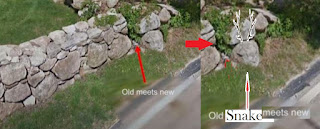Hobbomok appears in dreams in many forms,
including a deer, a man, or an eagle,
but his favorite forms are the eel and the snake.
“Horned
Serpent: Only a few Wampanoag representations of horned serpents have survived,
but they seem to have been substantially the same as in other Algonquian
tribes: giant snake-like water monsters with horns that lurked in lakes and
rivers and ate people. In the Wampanoag tribe, horned serpents were associated
with Cheepi (Hobbomock), who would sometimes take the form of a horned serpent.”
http://www.native-languages.org/wampanoag-legends.htm
|
Abbomocho
(Hobbomock, Chepi) |
The
Healing Spirit |
The
Spirit of Death, night, northeast wind, the dark and the underworld. To
the English Hobbomock meant the Devil, Evil Spirit |
by
Dr. Frank Waabu O'Brien, Aquidneck Indian Council
Hobomock
Also
known as: Chepi, Chipi, Cheepie,
Cheepee, Cheepi, Cheepii, Chepian (pronounced
chee-pee in Wampanoag.)
Tribal
affiliation: Wampanoag, Narragansett, Mohegan, Pequot (MA, RI, and CT)
In
Wampanoag and Narragansett traditions, Hobomock was the manito (spirit) of
death-- a destructive, often evil being usually in opposition to Kautantowit.
Hobomock was sometimes also referred to as "Chepi,"
which means "ghost" in Wampanoag. Hobomock is the subject of many
Wampanoag 'bogeyman' stories, warning children away from dangerous or naughty
behavior. In other legends, Hobomock plays macabre tricks on adults such as
stealing their eyelids so that they can never sleep again or twisting their
feet to make them lame. After the introduction of Christianity, Wampanoag and
Narragansett people began to identify Hobbomock with the Devil.
http://www.native-languages.org/hobomock.htm
Jipijka'm
Tribal affiliation: Mikmaq
Alternate spellings: Jupijkám, Tcipitckaam, Chipitchkam,
Chepitchcalm, Kchi Pitchkayam, Ktchi Pitchkaam, Chepechcalm, Chepichkaam,
Chepitchkaam, Che-Pitch-Calm, Chepichealm, Jibichkam, Jipijkma, Chepitkam,
Ktchi-Pitchkayam
Pronunciation: chih-pitch-kawm
Also known as: The plural form of their name is Jipijkamak or
Jipijkmak, and the female form is Jipijkamiskw or Jipijkamiskwa.
Type: Lake monsters, serpents
Related figures in other tribes: Kci-Athussos (Maliseet), Tatoskok (Abenaki), Mishiginebig (Anishinabe), Maneto (Fox)
Jipijka'm is a great horned serpent, common to the legends of
most Algonquian tribes. It is said to lurk in lakes and eat humans. Since it
has only one horn according to most Mi'kmaq stories, it is sometimes called the
Unicorn Serpent in English. Its horn is usually described as red and yellow and
has powerful magical qualities.
http://www.native-languages.org/jipijkam.htm
Hobbomok
appears in dreams in many forms, including a deer, a man, or an eagle, but his
favorite forms are the eel and the snake. Terrifyingly, Hobbomok also sometimes
appears as a European, as John Josselyn recorded in 1674:
"Another
time, two Indians and an Indess, came running into our house crying out they
should all dye, Cheepie (Hobbomok) was gone over the field gliding in the air
with a long rope hanging from one of his legs: we askt them what he was like,
they said all wone Englishman, clothed with hat and coat, shooes and
stockings."
(William Simmons' Spirit of the New England Tribes, and Kathleen
Bragdon's Native People of Southern New England, 1500-1650.)
http://newenglandfolklore.blogspot.com/2010/05/hobbomok-and-shamanic-power.html























































